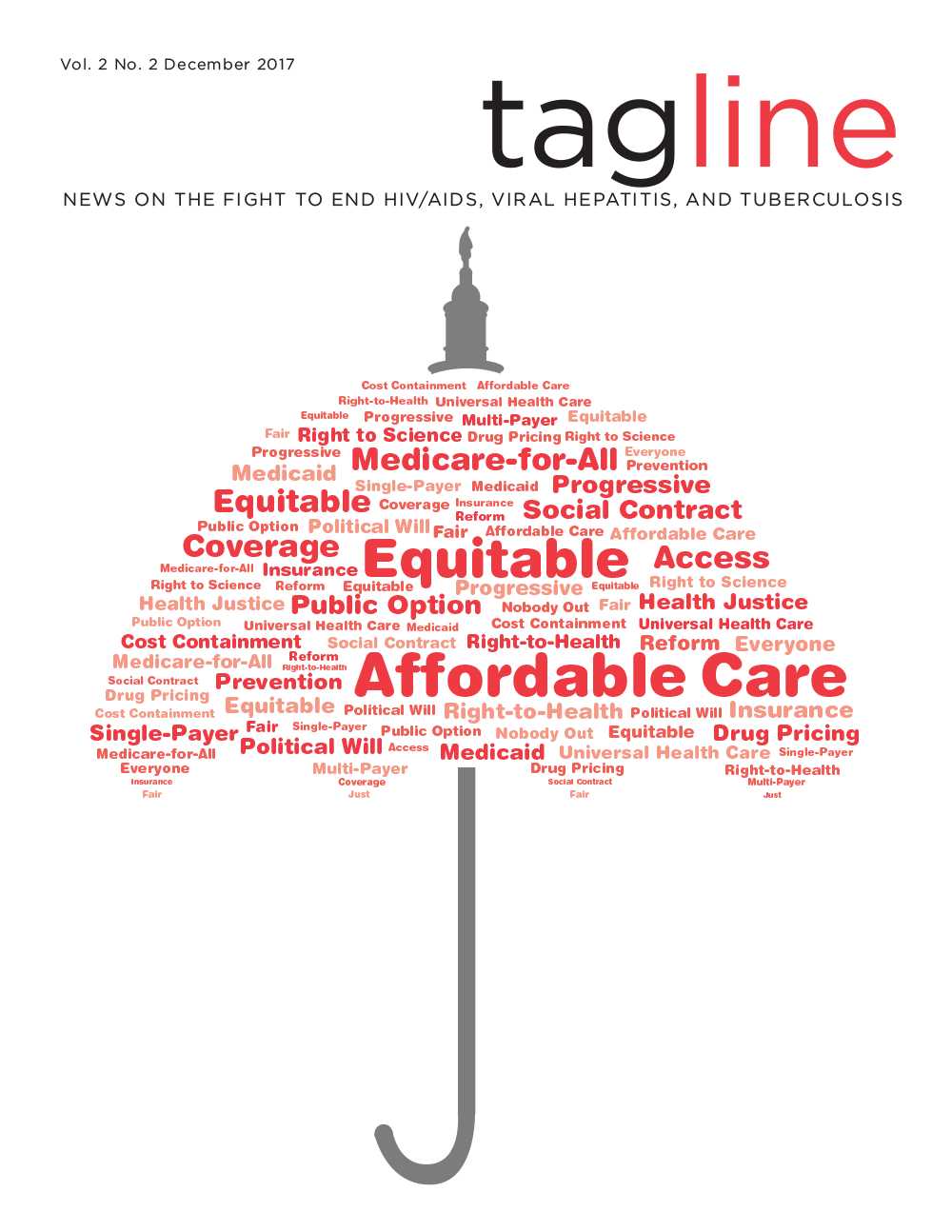How U.S. southern states are moving ahead without full health care coverage
By Jeremiah Johnson & Kenyon Farrow
 Activists and health departments around the country continue to advance strategies to ‘End the Epidemic’ (EtE) in their jurisdictions, yet a central question remains. Are these ambitious plans appropriate in all U.S. jurisdictions, particularly given uneven access to health care systems? In places such as New York State, Washington State, and Washington, DC, Medicaid expansion through the Affordable Care Act (ACA) has made it possible to provide nearly all uninsured people with comprehensive health care, including free HIV testing and pre-exposure prophylaxis (PrEP) access. In these settings, a call to end HIV/AIDS as an epidemic through increased testing, linkage to care and treatment, and comprehensive prevention services seems more feasible. But with Louisiana being the only state in the Deep South that has expanded Medicaid to date, are EtE strategies realistic in the southern U.S.?
Activists and health departments around the country continue to advance strategies to ‘End the Epidemic’ (EtE) in their jurisdictions, yet a central question remains. Are these ambitious plans appropriate in all U.S. jurisdictions, particularly given uneven access to health care systems? In places such as New York State, Washington State, and Washington, DC, Medicaid expansion through the Affordable Care Act (ACA) has made it possible to provide nearly all uninsured people with comprehensive health care, including free HIV testing and pre-exposure prophylaxis (PrEP) access. In these settings, a call to end HIV/AIDS as an epidemic through increased testing, linkage to care and treatment, and comprehensive prevention services seems more feasible. But with Louisiana being the only state in the Deep South that has expanded Medicaid to date, are EtE strategies realistic in the southern U.S.?
TAG is currently working in partnership with the Southern AIDS Coalition to provide capacity and technical support in three southern jurisdictions interested in launching EtE strategies: Louisiana, Alabama, and Nashville, Tennessee (Fulton County, GA, and Houston, TX, have been implementing their own EtE strategies). Not only are there clear reasons for the advancement of EtE strategies in these jurisdictions, there is also tremendous determination among community activists and health departments to take full advantage of existing opportunities despite the failure of Republican governors to accept federal assistance to expand health care coverage for the poor and marginalized residents in their state.
Increased advocacy and key stakeholder involvement in southern jurisdictions in which EtE initiatives are moving forward can lead to better utilization of existing HIV/AIDS funds available through the Ryan White program.
“Southerners are known for their creativity and ability to stretch a dollar,” says Carolyn McAllaster, Director of the Duke HIV/AIDS Policy Clinic and the Southern HIV/AIDS Strategy Initiative (SASI). “Most southern states are using their AIDS Drug Assistance Program (ADAP) to help pay for medical insurance including premiums, co-payments, and co-insurance costs.”
Melanie Thompson, chair of the prevention and care committee on the HIV/AIDS task force in Fulton County, GA, echoed the possibilities of leveraging Ryan White funds to gain access to broader health care coverage. “We’re expanding the use of Ryan White funds to pay for the Health Insurance Continuation Program (HICP), which has been happening for quite a while,” she said, referring to the use of federal and state dollars to cover private health insurance premium costs for people living with HIV. “The Strategy to End AIDS in Fulton County recommends forming a working group to troubleshoot issues with HICP/ADAP, and that suggestion has now been approved by the Georgia Department of Public Health.”
Ryan White, particularly at current funding levels, is not enough to address the needs of the ever-growing HIV-positive patient population it is meant to serve. With increased advocacy, however, Ryan White may increase insurance access for more people living with HIV with little to no income, improving outcomes on health issues that require specialty care not covered by Ryan White. Community mobilization under EtE initiatives may also ensure that Ryan White programs are running efficiently with no lag time between diagnosis, linkage to care, and access to medications.
In the last few years, the Centers for Disease Control and Prevention (CDC) and Health Resources and Services Administration (HRSA) have strongly encouraged—and in most cases required—that jurisdictions develop integrated plans for the care, treatment, and prevention of HIV. The hard work to develop these integrated plans has created new opportunities for better coordinated efforts within state governments and potentially lessened the administrative burden of submitting separate care and prevention plans, which was required in the past. With this restructuring only recently completed, some southern jurisdictions may wonder what added benefit an EtE plan would provide.
To end epidemics, marginalized communities also need plans that provide solutions to the social and structural determinants of health that drive HIV epidemics and are frequently left out of jurisdictional plans. Arizona recognized this need in developing their integrated plan and decided to mobilize community early in that planning process, addressing structural barriers and stigma more specifically in the recommendations and effectively turning their integrated plan into an EtE document.
States with conservative governors who have refused to expand Medicaid are perhaps the most in need of this enhanced collaboration between key stakeholders and increased advocacy. McAllaster agreed, “EtE initiatives can push policy makers who are not typically focused on HIV to become engaged. I’m thinking of city mayors who, for the most part, stay silent on the issue of the HIV epidemic.”
Even if expansion remains unlikely, plans can push state and city governments and health departments to more intently focus on barriers to care and treatment, better coordinate resources, and advocate for Medicaid waivers that are friendly for HIV and vulnerable populations.
Even without Medicaid expansion, southern states have the opportunity to improve linkage to care and PrEP access. Many jurisdictions are already having some success with this. With increased attention and advocacy through EtE planning, successes in the region may be translated and replicated.
According to Thompson, “six clinics have implemented pilot Rapid Entry programs in keeping with a recommendation from the Strategy to End AIDS in Fulton County, with initial medical visits on the same day or within three days of initial presentation or presentation for reengagement. Of these, four received specially targeted Ryan White funds to begin their clinics.”
Even without EtE initiatives, other southern states have found creative ways to improve linkage to care. In much of the South, large percentages of people living with HIV reside in rural areas, differing from the character of the epidemic in the rest of the country. Thanks to the efforts of community advocates, North Carolina and Alabama have implemented telemedicine to treat individuals living outside of large urban areas. In addition, several states, including Louisiana, North Carolina, and Virginia, have launched data-to-care strategies: using surveillance information to notify health care workers when a patient they’re seeing may have fallen out of care.
Finding those windows of opportunity to link people living with HIV to support and health care services is key. According to McAllaster, “The Corrections Navigation Program that was implemented in 2014 in Tennessee is an important initiative to provide persons living with HIV who are being released from prison with enhanced transitional case management and incentives to promote linkage to medical care.”
McAllaster also notes that, where PrEP access is concerned, southern jurisdictions are on the move. “There are an increasing number of community health centers that provide access to PrEP as well as HIV treatment,” McAllaster explained. “An example would be the Open Arms Clinic in Jackson, MS. In Jacksonville, FL, the non-profit JASMYN is focused on LGBTQ youth ages 13 to 23, providing them with services and advocacy, including an STI clinic, HIV care linkage services, case management, transportation, social activities, and support groups.” State AIDS Education and Training Centers are improving provider knowledge about PrEP, and several clinics have gotten foundation or other funding for PrEP clinics.
A key component of EtE strategies is the ownership and leadership of affected communities in every step of drafting, finalizing, implementing, and evaluating the final plan. Stronger community organizing among people living with or vulnerable to HIV in the South is perhaps one of the most important opportunities that emerges out of this process. With very dire circumstances in southern states involving limited resources, high levels of HIV and LGBT stigma, and hostile political environments, building a critical mass of people living with or vulnerable to HIV who are willing to directly challenge elected officials and the political establishment can be a daunting task. Ending HIV, as a campaign framework, creates new possibilities to mobilize people living with HIV in what have historically been more difficult political climates.
EtE campaigns give key stakeholders a broad platform to advance new, ambitious policy changes. With the advent of PrEP and proof that people with HIV who are successfully on treatment and virally suppressed cannot pass on the virus to others even with condomless sex, a whole range of new arguments are available for advancing policy and program changes at the city, county, or state level that increase access to effective prevention and treatment while decreasing the stigmatization and criminalization of affected communities.
In addition to using an EtE framework to unite a number of prevention, treatment, and structural policy issues under one umbrella, EtE campaigns can be a great way to highlight the cost of not expanding Medicaid in Southern states. In June 2017, the Mississippi Department of Health announced that it was closing one of its STD clinics in Jackson. Even worse, it would also begin charging $25 for an HIV test in the poorest state in the country.
An EtE campaign in a place such as Jackson, MS—where TAG is looking to begin work with community leaders in this jurisdiction in early 2018—could effectively scale up public pressure on the state to show the cost of divestment in public resources for comprehensive health coverage through Medicaid. According to estimates, nearly 300,000 people in Mississippi would qualify for Medicaid under the expansion, and the state would receive $427 million in new funding from the federal government. So although Southern jurisdictions that haven’t expanded Medicaid can still do a lot under an EtE plan, it should dovetail with advocacy for Medicaid expansion under the ACA.
Despite the ongoing struggles to expand Medicaid in Republican-controlled states and relentless federal attacks on the ACA, we believe the time to continue pushing for the resources to end the HIV epidemic in the U.S. is now. Several opportunities are still available in the South, all of which are dependent on community leadership as part of an EtE process.
